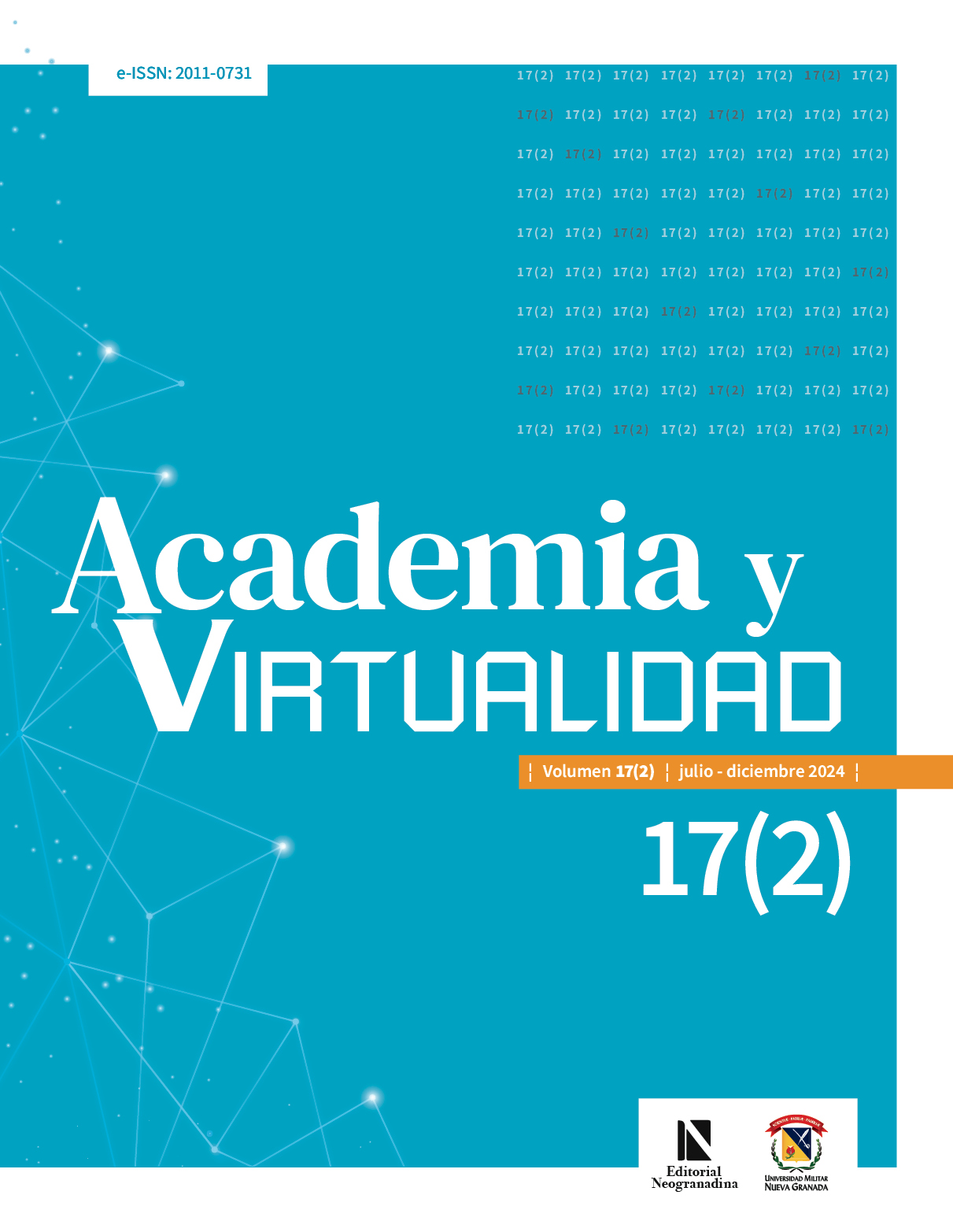Transição da educação presencial para a virtualidade: compreendendo o eu dos alunos.
Resumo
Este estudo de investigação qualitativa teve como objetivo descrever a transição da educação presencial para a educação virtual, a fim de compreender, como professores, a vida pessoal e académica dos estudantes antes e durante a pandemia. Este estudo descritivo foi realizado com um grupo de estudantes de diferentes cursos de uma instituição pública em Tunja, Boyacá, Colômbia. Para a categorização dos dados, foram considerados quatro aspectos relevantes: comportamental, motivacional, afetivo-emocional e cognitivo. Os dados serão recolhidos através de um questionário e de notas tomadas pelos professores dos investigadores. A interpretação dos resultados leva a uma reflexão profunda, a fim de orientar uma mudança, se necessário, nas práticas de ensino actuais.
Downloads
Referências
Arnold, J. (Ed.). (1999). Affect in Language Learning. Cambridge University Press.
Bloom, B. S. (1956). Taxonomy of Educational Objectives. Handbook I: The Cognitive Domain. David McKay Co Inc.
Bloom, B. S., Engelhart, M. D., Furst, E. J., Hill, W. H., and Krathwohl, D. R. (1956). Handbook I: cognitive domain. David McKay Co Inc.
Botelho, C. L. M. (2022). High School Teachers’ Experiences with Student Smartphone Addiction (Doctoral dissertation, Grand Canyon University).
Dweck, C. S. (1999). Self-theories: Their role in motivation, personality, and development. Psychology Press.
Freeman, R. (1993). Language Planning and Identity Planning for Social Change: Gaining the Ability and the Right to Participate, Unpublished doctoral dissertation, Georgetown University.
Guillén-Gámez, F. D., y Peña, M. P. (2020). Análisis Univariante de la Competencia Digital en Educación Física: un estu- dio empírico. Retos, 37, 326-332. https://doi.org/10.47197/retos.v37i37.72052
Hidi, S., and Renninger, K. A. (2006). The four-phase model of interest development. Educational psychologist, 41(2), 111- 127. https://doi.org/10.1207/s15326985ep4102_4
Holzer J, Korlat S, Haider C, Mayerhofer M, Pelikan E, Schober B, et al. (2021). Adolescent well-being and learning in times of COVID-19 A multi-country study of basic psychological need satisfaction, learning behavior, and the mediating roles of positive emotion and intrinsic motivation. PLoS ONE 16(5): e0251352. https://doi.org/10.1371/journal.pone.0251352
Iglesias, S., Hernández, A., Chaparro, J., and Prieto, J. (2021). Emergency remote teaching and students’ academic performance in higher education during the covid-19 pandemic: A case study. Computers in Human Behavior, (119). https://doi.org/10.1016/j.chb.2021.106713
Jenkins, J. M., and Oatley, K. (1996). Emotional episodes and emotionality through the lifespan. In Handbook of emotion, adult development, and aging (pp. 421-441). Academic Press. DOI: https://doi.org/10.1016/B978-012464995-8/500248
Järvelä, S., and Renninger, K. A. (2014). Designing for learning: Interest, motivation, and engagement. In R. K. Sawyer (Ed.), The Cambridge handbook of the learning sciences (pp. 668-685). Cambridge University Press. https://doi.org/10.1017/CBO9781139519526.040
Krathwohl, D. R., Bloom, B. S., and Masia, B. B. (1964). Taxonomy of educational objectives, Book II. Affective domain. (New York, NY: David McKay Company, Inc.).
Kanfer, R. (2015). Successful aging at work: The role of job crafting. In P. M. Bal, D. T. A. M.
Krashen, S. (1982). Principles and practice in second language acquisition. Pergamon Press Inc.
Lankshear, C. and Knobel, M. (2004). A Handbook for Teacher Research: from design to implementation. Open University Press.
LeDoux, J. E. (1996). The emotional brain: The mysterious underpinnings of emotional life. Simon and Schuster.
Linnenbrink-Garcia, L., and Patall, E. A. (2016). Motivation. In L. Corno and E. M. Anderman (Eds.), Handbook of educational psychology (pp. 91-103). Routledge/Taylor and Francis Group.
Mack D, DaSilva A, Rogers C, Hedlund E, Murphy E, Vojdanovski V, Plomp J, Wang W, Nepal S, Holtzheimer P, Wagner D, Jacobson N, Meyer M, Campbell A, and Huckins J. (2021). Mental Health and Behavior of College Students During the covid-19 Pandemic: Longitudinal Mobile Smartphone and Ecological Momentary Assessment Study, Part II. J Med Internet Res 23(6). https://doi.org/10.2196/28892
Matrosova, S. (2021). From Resistance to Acceptance: Technology in Academia (Doctoral dissertation, Capella University).
Merriam, S. B. (1998). Qualitative research and case study applications in education. Jossey-Bass.
Murayama, K., Pekrun, R., Lichtenfeld, S., and Vom Hofe, R. (2013). Predicting long‐term growth in students’ mathematics achievement: The unique contributions of motivation and cognitive strategies. Child development, 84(4), 1475-1490. https://doi.org/10.1111/cdev.12036
O’Donohue, W., and Kitchener, R. (Eds.). (1998). Handbook of behaviorism. Elsevier
Omar, M., Hassan, M., Arsad, N., Ismail, N., Jamaluddin, R. and Jusoh, R. (2021) Undergraduates Students’ Learning Experience on the Impact of Online Learning during Pandemic. Open Journal of Social Sciences, 9, 167-184. https://doi.org/10.4236/jss.2021.99012.
Pintrich, P. R. (2003). A Motivational Science Perspective on the Role of Student Motivation in Learning and Teaching Contexts. Journal of Educational Psychology, 95(4), 667-686. https://doi.org/10.1037/0022-0663.95.4.667
Pritchard, A. M. (2014). (3ed). Ways of learning: Learning theories and Learning Styles in the Classroom. Routledge. https://doi.org/10.4324/9781315852089
Russell, J. A., and Barett, L. F. (2009). Core affect, prototypical emotional episodes, and other things called emotion: Dissecting the elephant. Journal of Personality and Social Psychology, 76(5), 805-819. http://doi.org/10.1037/00223514.76.5.805
Saavedra, G. (2014). The use of Skype to expose students to a cooperative learning environment through oral interactions tasks. Universidad Pedagógica y Tecnológica y Tecnológica de Colombia. Tunja, Boyacá, Colombia.
Scovel, T. (2000). Learning new languages: A guide to second language acquisition. Heinle and Heinle.
Skinner, B. F. (1957). Verbal behavior. Appleton Century Crofts. https://doi.org/10.1037/11256-000
Unger, S., and Meiran, W. R. (2020). Student attitudes towards online education during the covid-19 viral outbreak of 2020: distance learning in a time of social distance. International Journal of Technology in Education and Science, 4(4), 256-266. https://doi.org/10.46328/ijtes.v4i4.107
Watson, J. B. (1924). Behaviorism. Routledge
Yeager , D. S., and Walton, G. M. (2011). Social-psychological interventions in education: They’re not magic. Review of Educational Research, 81(2), 267-301. https://doi.org/10.3102/0034654311405999
Copyright (c) 2024 Academia y Virtualidad

Este trabalho está licenciado sob uma licença Creative Commons Attribution-NonCommercial-NoDerivatives 4.0 International License.











